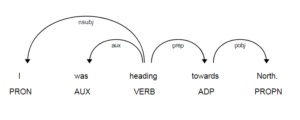Introduction
In this article, we will take you through the tutorial of Dependency Parser and Dependency Tree in Spacy. We will discuss what is dependency parsing and then understand Spacy dependency parser with examples. Finally, we will show you how to visualize with the help of the dependency tree in Spacy.
Dependency Parsing
Dependency parsing is the process of generating the relationship among different words of a sentence and describing their syntactic roles.
E.g. in the phrase ‘running fast’, the dependence relation between the words is the ‘admov’ tag which stands for an adverbial modifier. Here “fast” is the child and “running” is the head text.
Similar to this, there exist many dependencies between words in an English sentence.

Spacy Dependency Parser
The Spacy library has a fast and accurate syntactic dependency parser which return various dependence parse tag describing the relationship between two words in a sentence. It has around 41 dependency parse tags.
Spacy also has a feature to visualize it by using the dependence tree and also has a bunch of options to access the dependence tree.
The dependence parse also provides input to sentence boundary detection in spacy and helps in iterating over noun phrases or chunks.
Example of Spacy Dependency Parser
In the below example of Spacy dependency parser, the attribute dep_ returns the dependency tag of a word and head.text returns the respective headword.
import spacy
nlp=spacy.load('en_core_web_sm')
text='I was heading towrds North'
print(f"{'Token':{8}} {'dependence':{6}} {'head text':{9}} {'Dependency explained'} ")
for token in nlp(text):
print(f"{token.text:{8}} {token.dep_+' =>':{10}} {token.head.text:{9}} {spacy.explain(token.dep_)} ")
Token dependence head text Dependency explained I nsubj => heading nominal subject was aux => heading auxiliary heading ROOT => heading None towrds dobj => heading direct object North npadvmod => heading noun phrase as adverbial modifier
Dependency Parser Lists in Spacy
We can get the list of dependency parser in Spacy by using nlp.pipe_labels[‘parser’]
In [2]
import spacy
nlp = spacy.load("en_core_web_sm")
parser_lst = nlp.pipe_labels['parser']
print(len(parser_lst))
print(parser_lst)
[Out] :
41 ['ROOT', 'acl', 'acomp', 'advcl', 'advmod', 'agent', 'amod', 'appos', 'attr', 'aux', 'auxpass', 'case', 'cc', 'ccomp', 'compound', 'conj', 'csubj', 'csubjpass', 'dative', 'dep', 'det', 'dobj', 'expl', 'intj', 'mark', 'meta', 'neg', 'nmod', 'npadvmod', 'nsubj', 'nsubjpass', 'nummod', 'oprd', 'parataxis', 'pcomp', 'pobj', 'poss', 'preconj', 'predet', 'prep', 'prt', 'punct', 'quantmod', 'relcl', 'xcomp']
Spacy Dependency Tree Example
In the code below we are generating the dependency tree using Spacy’s displacy function.
The arc is used to represent the dependency between two words in which the word at the arrowhead is the child, and the word at the end of the arrow is the head. The term dep is used for the arc label, which describes the type of syntactic relation that connects the child to the head.
The root word can act as the head of multiple words in a sentence but is not a child of any other word. The word ‘heading’ here has multiple numbers of the outgoing arrows and no incoming arrows hence it is the root word.
Except for the root word, every word has exactly one head. One interesting thing about the root word is that if you start tracing the dependencies in a sentence starting from any word you finally reach the root word.
import spacy
from spacy import displacy
nlp=spacy.load('en_core_web_sm')
displacy.render(doc,jupyter=True)

Given below is a list of Dependency and their explanations.
| Dep | explain | |
|---|---|---|
| 0 | det | determiner |
| 1 | compound | compound |
| 2 | nsubj | nominal subject |
| 3 | amod | adjectival modifier |
| 4 | cc | coordinating conjunction |
| 5 | conj | conjunct |
| 6 | dobj | direct object |
| 7 | relcl | relative clause modifier |
| 8 | punct | punctuation |
| 9 | ccomp | clausal complement |
| 10 | prep | prepositional modifier |
| 11 | pobj | object of preposition |
| 12 | pcomp | complement of preposition |
| 13 | advmod | adverbial modifier |
| 14 | aux | auxiliary |
| 15 | mark | marker |
| 16 | nsubjpass | nominal subject (passive) |
| 17 | auxpass | auxiliary (passive) |
| 18 | advcl | adverbial clause modifier |
| 19 | appos | appositional modifier |
| 20 | dative | dative |
| 21 | acomp | adjectival complement |
| 22 | nummod | numeric modifier |
| 23 | attr | attribute |
| 24 | dep | unclassified dependent |
| 25 | agent | agent |
| 26 | expl | expletive |
| 27 | acl | clausal modifier of noun (adjectival clause) |
| 28 | npadvmod | noun phrase as an adverbial modifier |
| 29 | neg | negation modifier |
| 30 | xcomp | open clausal complement |
| 31 | intj | interjection |
Iterating over Children
The spacy function has token.children attribute using which we can get the list of children of head text.
import spacy
nlp = spacy.load("en_core_web_sm")
doc = nlp("I was heading towards North.")
for token in doc:
print(token.text, token.dep_, token.head.text, [child for child in token.children])
I nsubj heading [] was aux heading [] heading ROOT heading [I, was, towards] towards prep heading [North] North pobj towards []
- Also Read – Tutorial for Stopwords in Spacy Library
Reference – Spacy Documentation
-
This is Afham Fardeen, who loves the field of Machine Learning and enjoys reading and writing on it. The idea of enabling a machine to learn strikes me.
View all posts


